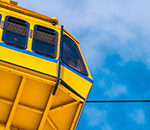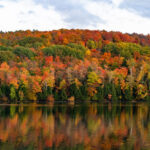Taking a great looking 10-minute exposure is a challenge at the best of times. But, in the daytime, it can be an especially finicky process. Photographer Stanley Klasz has taken many long exposures and has found 10 minutes to be the magic number for the look and feel he’s going for. This particular shot by Klasz, taken at Hamilton’s Fifty Point Conservation Area on Lake Ontario, is a 10-minute exposure at sunrise, resulting in a smooth, warm, and peaceful image:
Camera and Settings
- Canon EOS 5D Mark II
- Canon 24mm TS-EII
- Focal Length 24.0 mm
- Shutter Speed 608.0 sec
- Aperture f/8
- ISO 100
Although he used a tilt-shift lens, neither position was applied. Klasz used Formatt-Hitech filters – 16 Stop ND, Circular Polarizer and a Reverse Graduated filter, which he prefers because of the lack of color cast when shooting longer exposures. He used a Promote Control remote shutter.
“I’ve done a number of 10 minute exposures, I don’t know why I arrived at that particular number but for the feel of the image I’m trying to make it works for me. I approach a shot like this very carefully. It takes a lot of prep before the shot is taken, you have to double check everything. Focus, exposure settings, composition. 10 minutes is a long time to waste for one shot when the conditions are right. I’ve been to this location many many times, so I always have an idea of what I want to shoot before I get there. I do make judgement calls on everything on site, because there are so many variables that come into play with mother nature. And I’ll always do a multitude of different shots to keep all the bases covered.”
Like This Article?
Don't Miss The Next One!
Join over 100,000 photographers of all experience levels who receive our free photography tips and articles to stay current:






Beautiful shot! I wonder how much long exposure noise appeared after 10 mins exposure (this image looks quite clean, though [I’m viewing on my phone]). I primarily shoot cityscapes at dusk, but 10 mins exposure generates a ton of digital noise, especially on buildings. Probably the nature photography is more forgiving when it comes to long exposure noise, but would love to know if there are any tips to reduce long exposure noise. Thank you!
beautiful. I am not an early riser. I should do this for sunset and moon rise. Good technique and explanation
How do you use the reverse graduated filter: Cover the water with the dark site of the filter?
I like how the effect of the sunlight transitioning through the sky over a period of time compliments the foreground element and the smooth water.